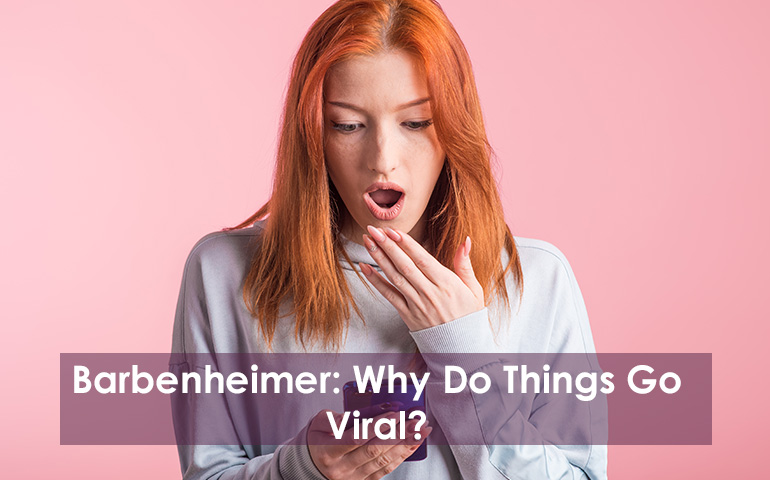
Barbenheimer: Why Do Things Go Viral?
by Chris Petry
I admit it. I fell prey to the Barbenheimer hype train. If you’re not active on one of the major social platforms (TikTok, Twitter, Facebook, Instagram) or pop culture/film industry news sites (Deadline, Hollywood Reporter, Variety, Screen Rant, Collider, etc.), you may be wondering what I’m talking about right now.
This week saw the simultaneous releases of Greta Gerwig’s Barbie, based on the popular doll line from Mattel, and Christopher Nolan’s epic biopic on the “Father of the Atomic Bomb,” Oppenheimer. Realizing these two films are worlds apart in tone and subject matter, and would not traditionally attract the same audiences, social media users decided to envision an alternate reality where said films could co-exist in the same fictional universe and thus play as the world’s most fascinating double feature. You can buy a t-shirt featuring Barbie looking on at a mushroom cloud in the distant horizon. A poster with Robert Oppenheimer taking Barbie in an impassioned embrace in a clear homage to Humphrey Bogart and Ingrid Bergman on the poster for the wartime, romance drama, classic, Casablanca.
The funny thing about all this? Box office analysts and industry insiders seem convinced that this organic viral marketing campaign, originating from the audience themselves, propelled both films to box office glory over the weekend. In fact, some people are so convinced that the press around the absurd pairing resulted in a near doubling of the projected gross for each film when tracked independently.
So why is this? Are the films good? Do they have star power? Well, none of that really matters. The real question is, why did this fan pairing go viral in the first place? Why does anything go viral? Remember the mannequin challenge? The ice bucket challenge? That time people were getting out of their cars while it was still in motion to perform an ill-advised dance number? To some of us, it may seem silly. Sometimes even dangerous. The reality is, these online user-fueled campaigns are today’s movie trailers, TV commercials, and billboards.
If someone asked you what an influencer was ten years ago, what would you have said? I know what I would have said. A what? Is a TikTok the sound a clock makes? Setting the terminology aside for a moment, the concepts are not new. There were always influencers. Think Michael Jordan and Nike. Remember those Dos Equis beer commercials featuring “The World’s Most Interesting Man?” I certainly remember being incentivized to visit McDonald’s in the early 90s because Michael Keaton was all over the packaging as promotion for Batman Returns. People bought a megaton of unnecessary products, simply because The Spice Girls, Van Halen, or Dr. Dre stamped their name on them. Look, if Diamond Dave says it’s cool, it’s cool.
TikTok is little more than an extension of concepts like America’s Funniest Home Videos. Only now, in addition to the funny pet videos and humorous mishaps, you can get recipe ideas, makeup tutorials, and unsolicited opinions on a whole host of “fascinating” topics. Its attraction is the same though. It allows us to live vicariously through others. Sometimes that means feeling good about ourselves because we didn’t fall down a flight of stairs while suspiciously carrying a box of marbles AND two cans of unopened latex paint. Other times we feel disappointed in ourselves because we’re on a staycation, in our sweats, curled around a bag of Flamin’ Hot Cheetos while our neighbor is flying to a private resort in Thailand.
Now, I’m sure people will point to the research regarding algorithms and how viewing or engaging with certain types of content will ensure you see more of it. I think there’s another, more primordial answer for how and why things go viral. It comes right down to the nature of what it means to be human. To want to be a part of something. To connect with others, usually but not always, in our social group. If you work in real restate for instance, you probably like being able to engage in conversation with other professionals in your field. The next time you sit down for your morning meeting and the discussion is focused on interest rates, chime in with, “Can you believe KK Downing isn’t in Judas Priest? What’s up with that?” Blank stares for days.
It all has to start somewhere. Somebody created the first Barbenheimer meme. It happened to resonate with a few people. Then even more people learn about it from their friends or followers. Next thing you know, everyone’s in on it. While there are certain ways to predict the interest in a selected topic, I think we have to accept that sometimes we just don’t know what will catch on and that’s part of the fun of it. The internet, for better or worse, has infused public discourse with a new air of spontaneity and uncertainty. Perhaps instead of being cynical and overly nostalgic, we have to take some things for what they are and run with it. Even if it confounds us. Looking back now, Myspace was social media’s Oppenheimer moment and much like the specter of atomic energy, the genie cannot go back into the bottle.





